Ma May Street, nestled in the historic Old Quarter of Hanoi, is a window into the rich cultural and architectural heritage of the city. A walk down this storied street is akin to stepping back in time, offering glimpses into the past while humming with contemporary vibrancy. Originally established in the 15th century, Ma May Street was known as a bustling hub for merchants and artisans, its atmosphere enriched by the diverse array of traditional crafts and trade activities.

Over the centuries, it has retained its historical essence, evident in the ancient architecture and cultural landmarks that whisper stories of old. This street, once a pivotal spot where commerce thrived, now stands as a harmonious confluence of the past and present, where visitors can soak in the flavors of Vietnamese life, both through its quaint architecture and vibrant street life. From its captivating boutiques showcasing local handicrafts to the aromatic blend of street foods enticing each passerby’s senses, Ma May Street stands as a testament to Hanoi’s historical journey and cultural evolution.
Historical Significance of Ma May Street
The historic core of Ma May Street stands as a testament to Hanoi’s complex past, weaving together architectural marvels with centuries of cultural upheavals. Revered for its historical architecture, the street provides a narrative of transformation and resilience, reflecting both Vietnamese and French colonial influences. It is a living museum that mirrors centuries of change, from the lavish merchant life of pre-colonial times to the resilience during the French rule and wars. The street preserves around 10% of Hanoi’s ancient houses, offering an authentic window into the architectural and cultural heritage of yesteryears. One of the most iconic structures, the Ancient House at 87 Ma May, vividly illustrates the lifestyle of affluent families during the Nguyen dynasty, with its intricate carvings and traditional layout setting a backdrop for Hanoi’s historical narrative.

Origins and Evolution of Ma May Street
Ma May Street’s origins trace back to a time when the air buzzed with the lively chatter of traders and artisans, a symbiotic mesh of commerce and tradition. Initially famed for its traditional crafts, the street bore witness to the merging of “Hang Ma” Paper Street and “Hang May” Fan Street. These names are emblematic of the specialized trades once practiced here, each trade carrying with it a lineage of skilled artisans dedicated to preserving traditional Vietnamese craftsmanship. As Hanoi developed, Ma May Street retained its importance due to both its strategic location and its cultural wealth.
When you walk through this historical street now, the echoes of the old world blend with the rhythm of modern life. The street has adapted, embracing current technological advancements and trends yet maintaining its antique charm. It is this marriage of past and present that draws visitors from around the globe, looking to explore the rich tapestries of Vietnamese history and tradition.
- Historic Landmarks:
- Ancient House at 87 Ma May
- Bach Ma Temple
- Quan Chuong Gate
- Architectural Styles:
- Vietnamese Traditional
- French Colonial
In the architectural dance of shadows and light on Ma May Street, each building tells a story. The area’s narrow alleyways envelop visitors in its legacy, and the vibrant energy remains palpable, making it not just a street but a journey through time. In these corridors, you’ll find stories unfolding at every corner, whether in the form of a quaint antique shop or a street vendor carrying forward family recipes passed down for generations. Thus, Ma May Street stands as a living, breathing testament to Hanoi’s resilience and evolution across centuries.
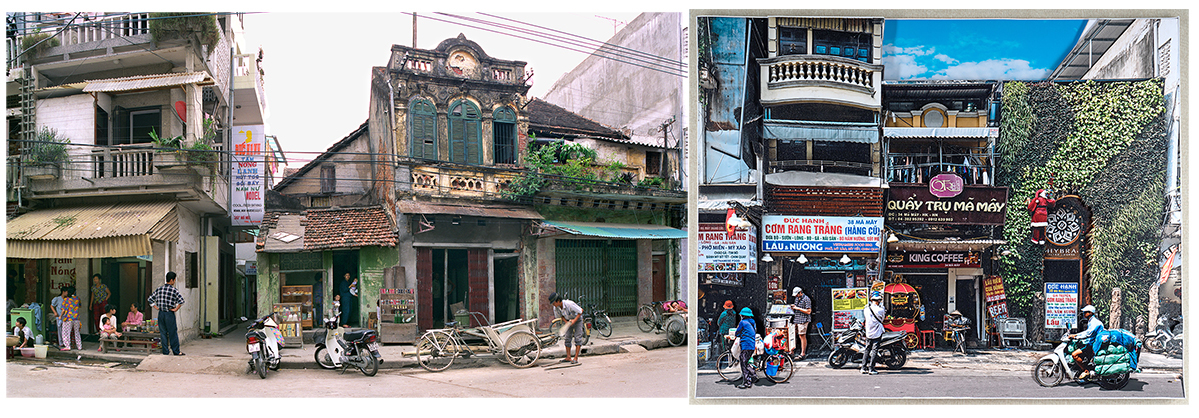
Architectural Heritage on Ma May Street
The architectural heritage of Ma May Street is an evocative tableau of Hanoi’s storied past. Unlike many modern streets, this lane has a distinctive character shaped over centuries. The most iconic symbol of Ma May’s architectural integrity is the Ancient House at number 87, a vibrant representation of traditional tube house design. These houses, constructed primarily from natural materials like wood and stone, showcase ingenious Vietnamese building techniques aimed at optimizing narrow urban spaces.
The street’s architecture is renowned for its unique harmonization of Vietnamese and colonial French designs, which are marvelously juxtaposed to create a landscape rich in history and innovation. Walking down Ma May Street, one is met with a visual tapestry: wooden structures adorned with intricate carvings that banter silently with French shutters and wrought-iron balconies, telling tales of cultural fusion.
A standout feature of these houses is their spatial composition, characterized by narrow facades opening up to elongated interiors that cleverly utilize courtyards for ventilation and lighting. Such clever adaptations reflect the adaptive spirit of Hanoi’s people in face of historical challenges, making these structures architectural time capsules.
- Key Architectural Features:
- Traditional Tube Houses
- Narrow Facades
- Wooden Carvings and Tiled Roofs
- Noteworthy Structures:
- French Colonial Balconies
- Intricate Interior Layouts
Each house and shop along Ma May Street cradles decades of history, inviting passersby to delve into the nuances of design elegance and cultural symbolism. Their enduring presence not only beautifies the street but also connects present-day Hanoi with its storied past, representing how even amid change, one can hold steadfast to identity and tradition an architectural symphony that continues to inspire and captivate the soul.

Cultural Aspects of Ma May Street
The cultural tapestry of Ma May Street is as rich as its architectural beauty. Embedded within the echoes of its ancient walls is the dynamic pulse of Hanoi’s vibrant cultural life. It is a place where tradition and modernity harmoniously coexist, enticing visitors with its plethora of traditional crafts and spirited local community. The street’s cultural significance is mirrored in its lively atmosphere, offering a genuine taste of Vietnamese daily life through artisanal shops, performances, and bustling marketplaces. This colorful mosaic is elevated by the artisans who keep traditional crafts alive, ensuring the vibrancy of the local community. Here, every day feels like a festival, with the vibrant hues of handicrafts, melodious tunes of folk music, and enticing aromas of street food all contributing to the unique cultural experience that truly defines Ma May Street.
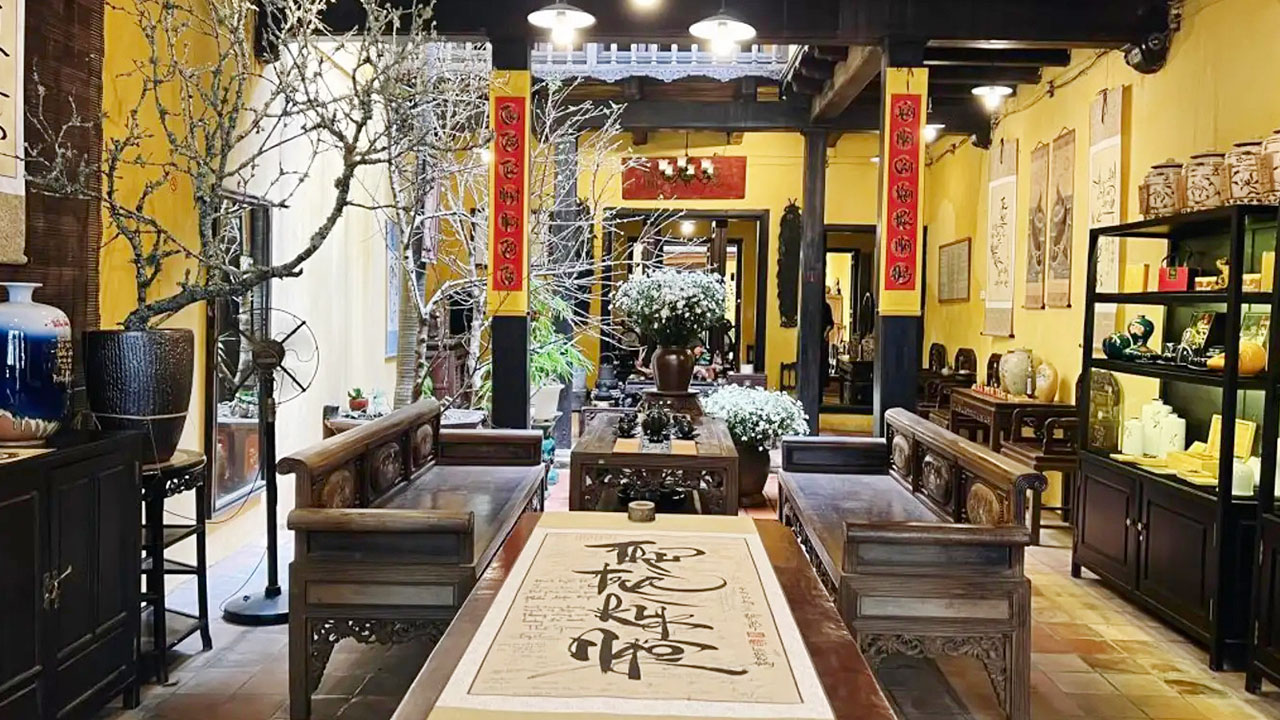
Traditional Crafts and Handicrafts on Ma May Street
Ma May Street has long been synonymous with the thriving world of traditional Vietnamese crafts, a sanctuary for artisans passionate about preserving the legacy of their forebears. Each shop and stall along the thoroughfare offers a window into the soul of Vietnam’s rich artistic heritage, showcasing a plethora of handcrafted items that reflect centuries-old techniques.
The street is particularly famous for its charming stalls that offer an array of local handicrafts stemming from revered traditional techniques. These crafts include intricate textiles, beautifully woven using age-old methods, and vibrant lanterns that illuminate the street’s nightly ambiance with a warm, inviting glow. Ceramics and pottery, often adorned with exquisite motifs, add to the appeal, embodying artistic expressions that narrate the historical essence of Vietnamese life.
- Popular Handicrafts:
- Intricate Textiles
- Handcrafted Jewelry
- Vibrant Paper Lanterns
- Artisan Techniques:
- Traditional Weaving
- Pottery Crafting
- Wood Carving
These crafts serve not only as a source of livelihood for many local artisans but also as a medium through which cultural stories are told, celebrated, and passed down to future generations. Walking through Ma May Street, visitors often pause to observe artisans at work, captivated by the deft movements and focused precision employed to create masterpieces from simple materials.
The craftsmanship on Ma May Street is more than just a visual delight; it serves as a testament to the dedication of artisans committed to preserving their cultural heritage amid an ever-evolving global landscape. This artistic dedication is a reminder of how history and tradition can beautifully merge with the present, creating a timeless continuity that resonates with both locals and visitors alike.
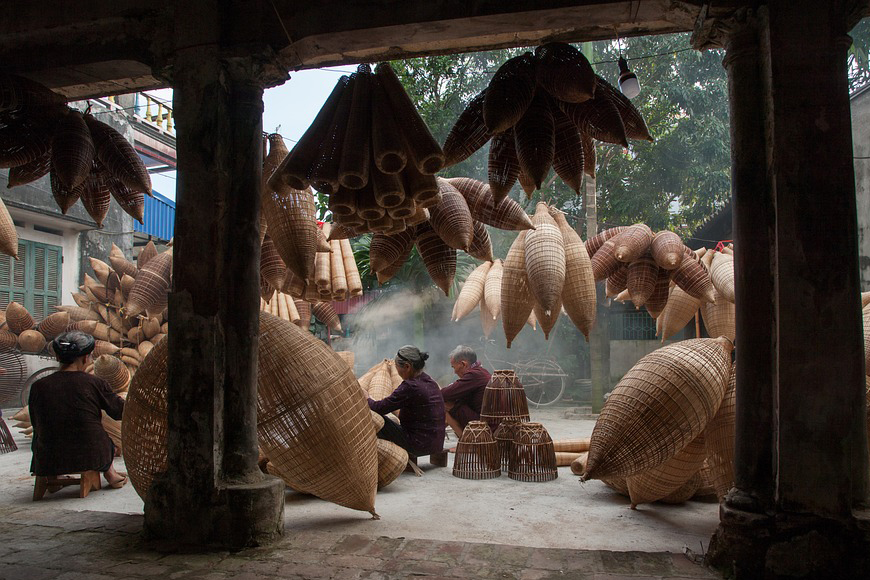
Modern-day Vibrancy and Local Community
The local community on Ma May Street is a vibrant mosaic of tradition interwoven with modern-day vivacity. This spirit is not only seen but felt in the colorful representation of both age-old customs and contemporary lifestyles seamlessly blended together. The street’s bustling atmosphere comes alive with vibrant markets, artisanal crafts, and culinary delights that paint a picture of authenticity and genuine local charm.
The dichotomy of traditional and modern is evident as you traverse this iconic street: ancient architecture stands shoulder to shoulder with more contemporary structures, serving as a reminder of the city’s dynamic narrative. Modern cafes and boutique shops occupy spaces that once housed ancient markets, now offering a haven for the city’s youth and visitors seeking a blend of old-world charm and new-age sensibilities.
- Key Elements of Modern-day Ma May:
- Boutiques and Artisan Shops
- Cafes and Modern Eateries
- Contemporary Art Displays
- Community Spirit:
- Local Events and Festivals
- Artisan-led Workshops
- Musical Performances
This rich intersection of the past and present fosters a unique sense of community, an emblem of Hanoi’s resilience amid rapid urbanization. Ma May Street remains not just a vital commercial hub but also a locality where tradition meets the pulse of contemporary city life, offering a resilient blend of nostalgia and modernity.
The local community on Ma May Street thrives, propelled by the very elements that once defined this historic neighborhood. Through creativity, resilience, and community, this enchanting street retains its heartbeat as a vital core of Hanoi culture, enticing every visitor with its lively embrace.
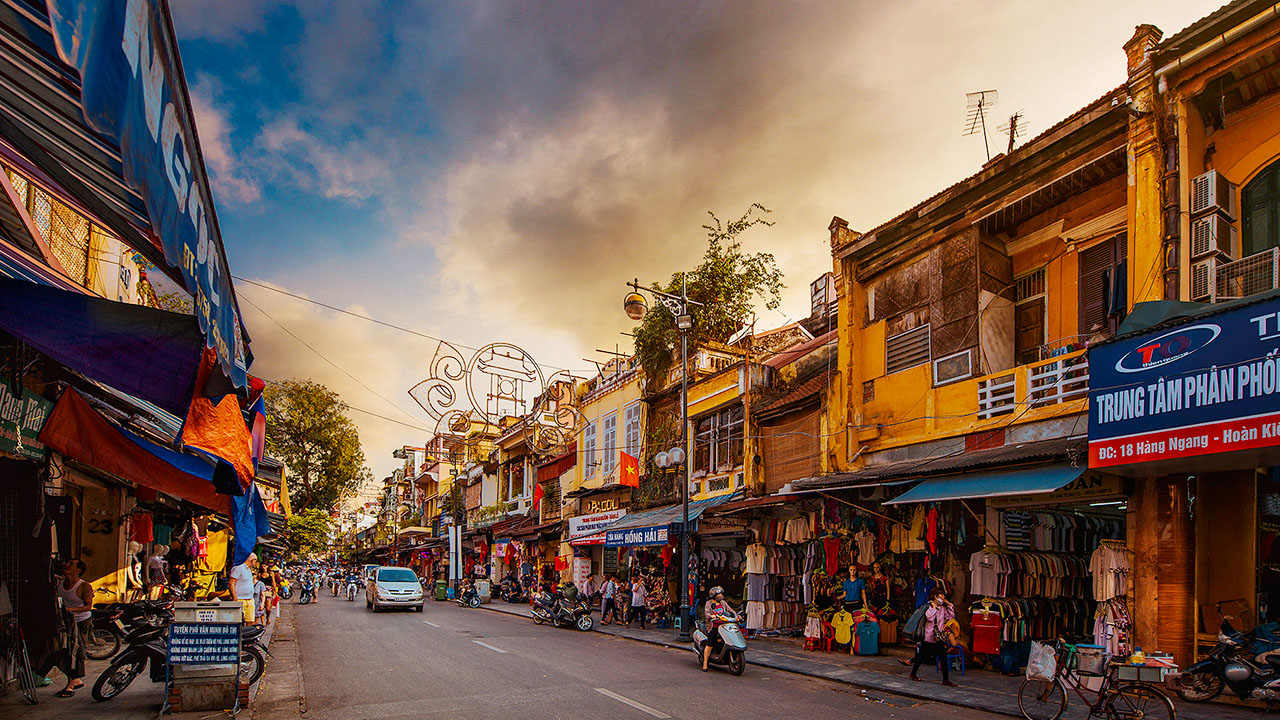
Culinary Delights on Ma May Street
Ma May Street is not only a feast for the eyes but also for the palate, drawing visitors with its array of culinary offerings that encapsulate the essence of Vietnamese cuisine. The street is a gourmet expedition, where one can savor a medley of flavors ranging from tantalizing street food to intricately crafted dishes in the cozy ambience of cafes and restaurants. The aroma of traditional dishes like phở, bánh mì, and nem rán fill the air, promising a gastronomic journey that tantalizes every taste bud. Additionally, the street is dotted with numerous cafés offering delightful brews, from the famous egg coffee to unique herbal teas. Here, the culinary scene not only celebrates the traditional but also embraces modern flavors, creating a delightful interplay for epicureans exploring the rich Vietnamese palette.
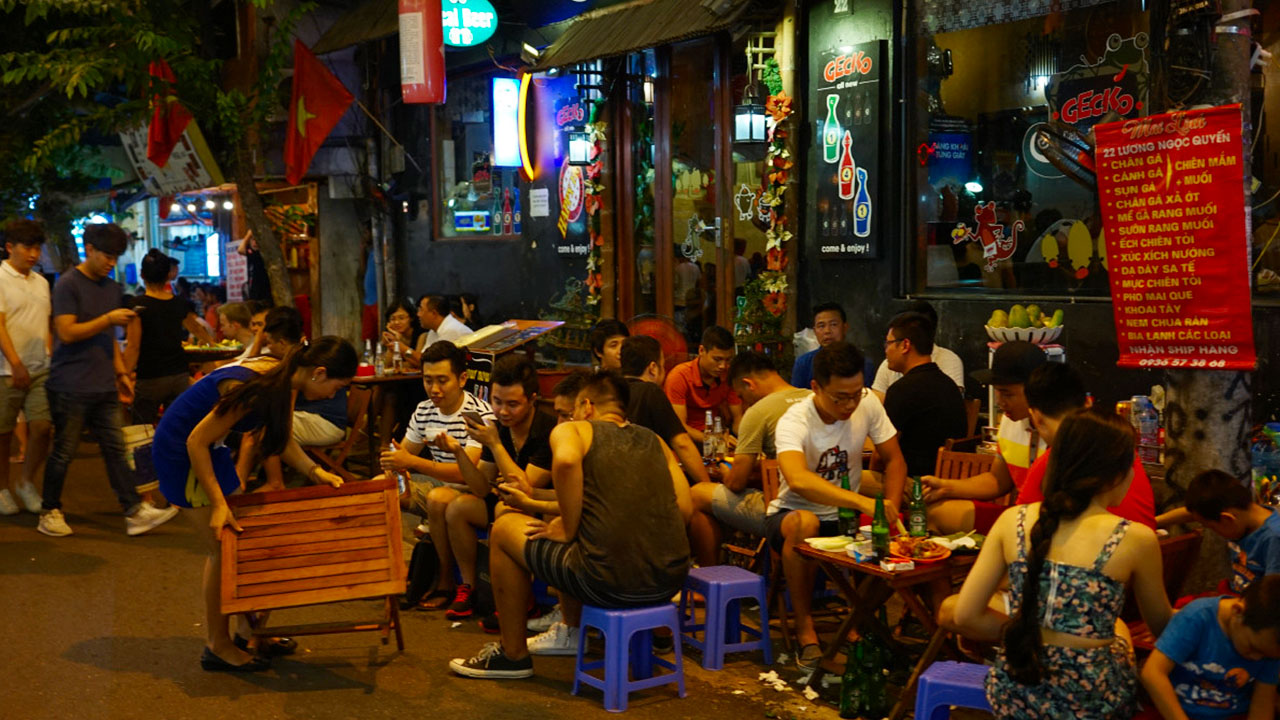
Street Food Offerings and Local Favorites
Ma May Street is nothing short of a gastronomic carnival where street food culture reigns supreme. The street food offerings here serve as a testament to the rich culinary traditions of Vietnam. The tantalizing aroma of food permeates the air, drawing in both locals and tourists with each flavorful promise.
One street food treasure to indulge in is the Nem Ran or fried spring rolls, a crispy delight with fillings like minced pork, vegetables, and glass noodles, all fried to golden perfection. Paired with fresh herbs and nuoc cham (dipping sauce), they offer a balanced fusion of flavors. Another beloved dish is Bun Cha, which comprises grilled pork and vermicelli noodles, offering a wonderful contrast of textures and flavors with every bite.
- Must-Try Dishes:
- Nem Ran (Fried Spring Rolls)
- Bun Cha (Grilled Pork with Vermicelli)
- Pho Cuon (Rice Noodle Rolls)
- Unique Beverages:
- Egg Coffee
- Herbal Iced Tea
Additionally, Pho Cuon rolls, a Hanoian specialty, provide a refreshing twist; these rice noodle rolls packed with herbs and grilled ingredients are not just delicious but also a healthier choice. Seafood enthusiasts must try Ca Kho To, which showcases caramelized catfish cooked in a rich clay pot broth, encapsulating the depth of Vietnamese flavors.
As you navigate through the street, mobile carts laden with these savory delights line the pathways, offering a visual treat and tantalizing scent. The experience is accentuated in the evenings when the street vendors at Ma May create a lively gastronomic theatre, ensuring every bite is a celebration of Vietnam’s culinary artistry.
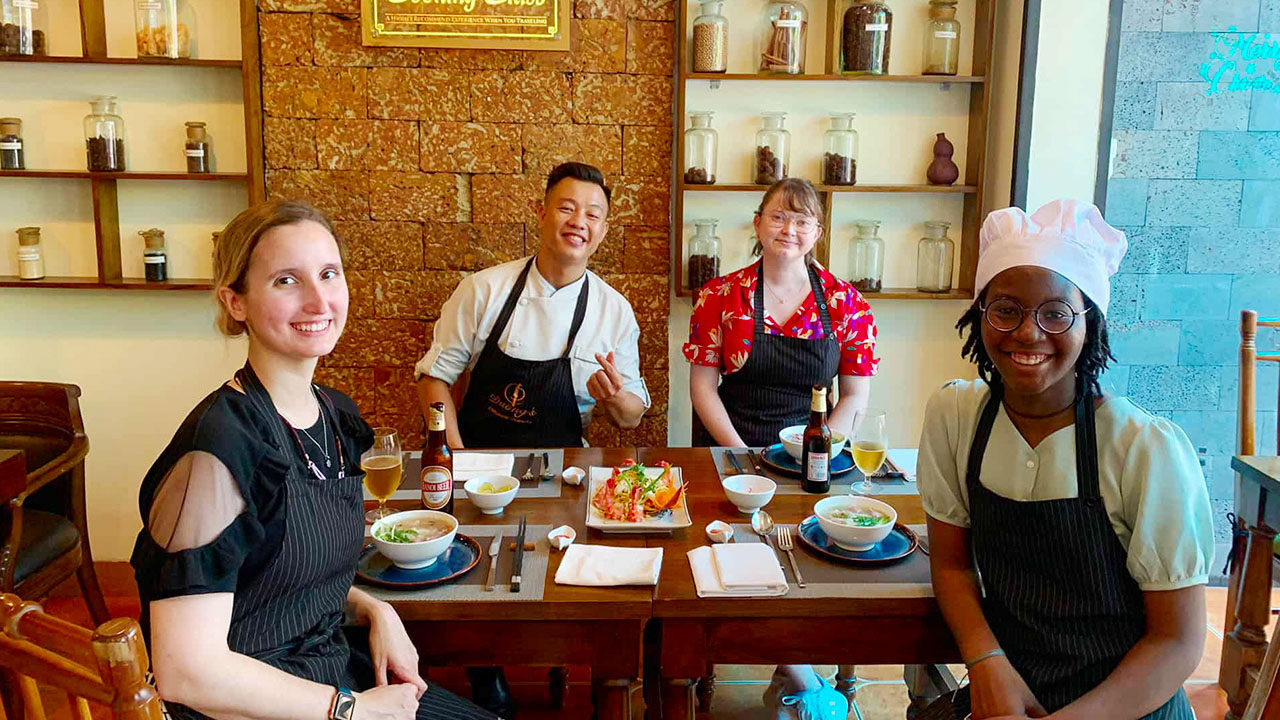
Restaurants and Cafés: A Taste of Hanoi
The eclectic mix of restaurants and cafés along Ma May Street offers visitors a taste of Hanoi in its truest sense. This stretch is a testament to the culinary diversity and gastronomic prowess inherent in Vietnamese culture, providing an authentic dining experience set against a backdrop of historical charm.
Among the renowned eateries is Highway 4, known for its innovative menu combining traditional dishes with a modern twist, celebrating local flavors in a cozy ambience. For a more upscale dining experience, Duong’s 2 Restaurant is a popular choice, offering delicately crafted meals that are akin to culinary art. These establishments do not just serve food; they present a narrative of Vietnamese culinary evolution.
- Popular Dining Spots:
- Highway 4
- Duong’s 2 Restaurant
- Red Bean Restaurant
- Local Delicacies:
- Bun Cha Hanoi
- Traditional Pho
- Banh Mi Variations
For those who prefer a more relaxed setting, Cafe Lam provides a charming escape with its classic egg coffee and banh mì, enjoyed from a humble first-floor balcony that dates back to the 1950s. Such locales offer not only a culinary feast but also an opportunity to soak in the historical ambiance of Ma May Street.
Each venue along this street, whether a casual café or an elegant restaurant, adds to the orchestral crescendo of culinary experiences available to visitors, offering them not just a taste but an insight into the very essence of Hanoi life through food.
Tourist Attractions Along Ma May Street
Beyond its culinary delights, Ma May Street captivates with its multitude of tourist attractions, each offering a glimpse into the cultural and historical heartbeat of Hanoi. This street, buzzing with life, becomes a rich tapestry of sights and experiences as one meanders through its vibrant lanes. From ancient houses beautifully preserved to lively night markets that celebrate the local zeitgeist, the attractions offer both historical intrigue and modern excitement. They present an opportunity for exploration and discovery, whether through the architectural charms of Ma May’s traditional structures or the bustling atmosphere of its tourist hotspots. Visitors are guaranteed an immersive journey that transcends mere sightseeing, offering them a chance to deeply connect with the spirit of Hanoi.

Ancient Houses and Historical Sites
Ma May Street is home to several ancient houses and historical landmarks, each whispering tales from the past against the backdrop of the city’s contemporary life. The street’s architectural landscape is dominated by these structures, which stand as sentinels to the rich and varied history of Hanoi.
A prominent feature is the renowned Ancient House at 87 Ma May, a living epitome of traditional Vietnamese architecture. Built in the late 19th century, this “tube house” captures the essence of classical design with its narrow façade that expands into a surprisingly spacious interior characterized by intricate woodwork and antique furnishings. As visitors wander through its serene courtyard, the harmony of the architectural elements offers a glimpse into the lifestyle and aesthetics during the Nguyen dynasty.
- Essential Sites:
- Ancient House at 87 Ma May
- Quan Chuong Gate
- Key Architectural Elements:
- Narrow Facades
- Spacious Interiors
- Intricate Woodwork
Another historical landmark is the Quan Chuong Gate, one of the four commanding fortress gates that once safeguarded Hanoi’s ancient defensive walls. This gateway remains a silent yet stoic sentinel overseeing all who pass through its arched structure, embodying the historical continuity of the city.
These historical sites provide rich insights into the bygone eras, offering a powerful narrative of Hanoi’s architectural and cultural evolution. Walking along Ma May Street is like taking a journey through time, where each ancient house and site allows visitors a glimpse into the chapters of history they represent, providing a tangible connection to the city’s storied past.
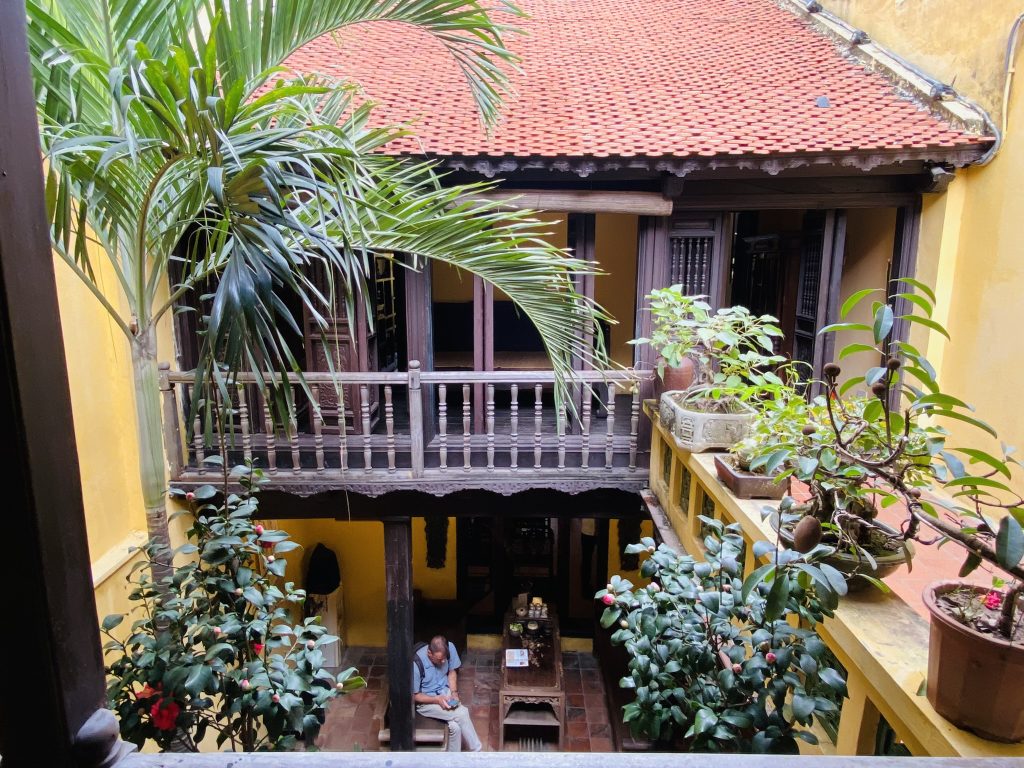
Temples and Places of Worship
The sacred landscape of Ma May Street is enriched by its temples and places of worship, which punctuate the street with serene retreats and spiritual testimony. Among these, Bach Ma Temple stands out as one of Hanoi’s oldest and a cultural bastion of spiritual heritage. Believed to date back to the 9th century, it is dedicated to the White Horse, the city’s mythical guardian spirit. This temple not only serves as a place of reverence but also as a conduit of tales and traditions that tether the past to the present.
As one steps into the tranquil confines of Bach Ma Temple, there is a sense of ceremonial reverence, emanating from the incense-laden air that greets visitors. The temple’s age-old architecture, encasing altars and relics, reverently holds secrets of ancient religious customs, offering a sanctuary amid the street’s bustling life.
- Prominent Places of Worship:
- Bach Ma Temple
- Quan De Temple
- Atmospheric Elements:
- Incense-laden Air
- Sacred Murals
- Ancient Altars
A short distance away, Quan De Temple supplements the sacredness of Ma May Street, creating a harmonious blend of religion and history. These spaces provide not merely an avenue for religious devotion but also a journey into Hanoi’s spiritual ethos and architectural beauty.
The temples and places of worship along Ma May Street are cornerstones of spiritual and historical learning, offering visitors a glimpse into the spiritual life that plays an integral part in the society’s cultural fabric. They are quintessential spaces where the physical beauty of Hanoi’s architecture meets the metaphysical reverence entrenched in its spiritual traditions.
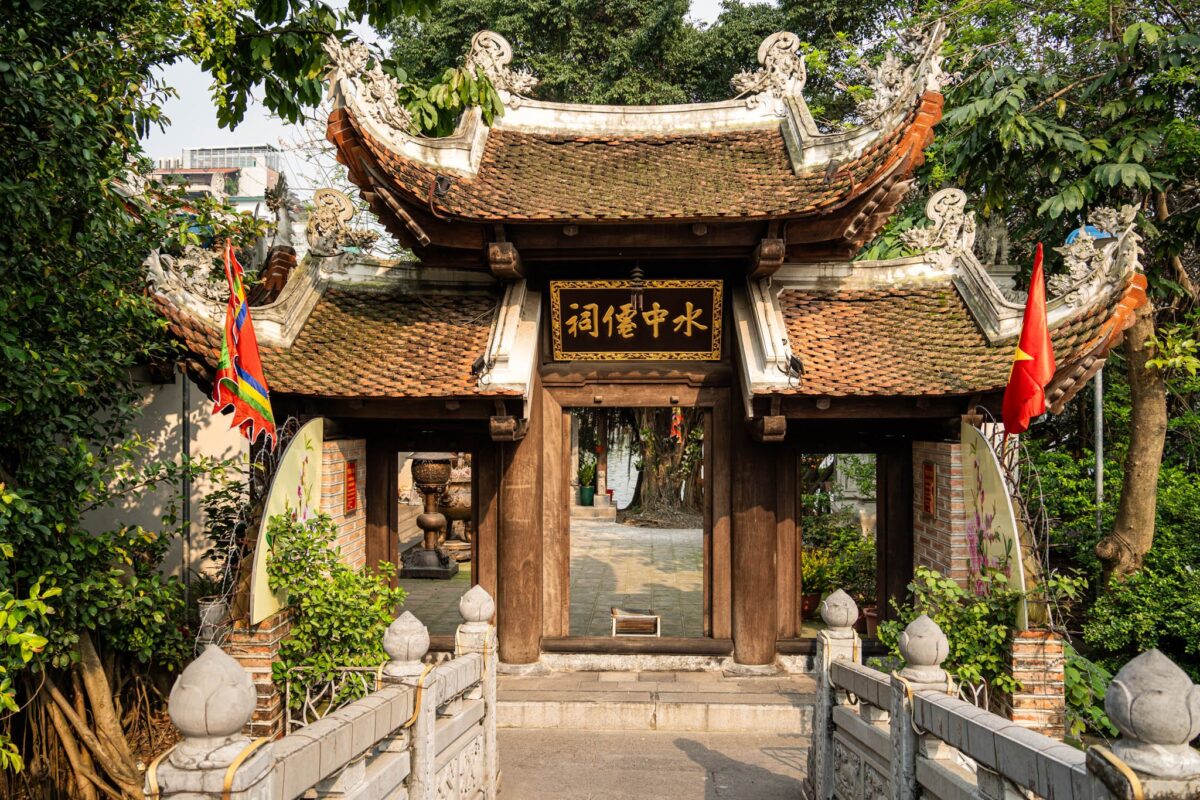
Entertainment and Nightlife on Ma May Street
As daytime adventures wind down, Ma May Street dazzles with its vibrant entertainment and nightlife. This iconic street morphs into a kaleidoscope of lights and sounds, an animated tapestry woven with nightlife escapades that beckon the night owl. Visitors are treated to an intriguing mix of bars, live music venues, and night markets. The intriguing ambiance invites guests to unwind and connect with the heartbeat of Hanoi’s nocturnal life. As the sun sets, Ma May’s streets teem with enthusiasm, catering to those eager to indulge in the spirited nightlife, with options aplenty to suit every likening, from laid-back hangouts to vibrant clubs resonating with local rhythms. Here, as wine glasses clink and new friendships are forged, the street’s nightscape springs to life, echoing the joie de vivre of Hanoi’s bustling nights.
Evening Activities and Night Markets
As evening descends, Ma May Street awakens from a gentle sleep into a lively scene of activity and allure. Known for its bustling night markets, the street draws a crowd eager to wander through stalls brimmed with intriguing wares and aromatic delicacies, creating a lively, bustling atmosphere.
The Hanoi Old Quarter Night Market, conveniently close to Ma May Street, is a staple for evening explorations. Open from 6 PM to midnight on weekends, it offers a delightful mix of traditional handicrafts, trendy apparel, and local street foods that offer authentic Vietnamese cuisine right on the bitumen stage, where hawkers delight the senses with their displays and scents.
- Notable Night Market Staples:
- Traditional Handicrafts
- Trendy Fashion Apparel
- Diverse Street Food
- Opening Hours:
- 6 PM to 12 AM (Primarily on weekends)
Engaging with this market is more than a shopping spree; it is an immersive escapade into the cultural fabric of Hanoi, unveiling nuanced, artistic expressions at every turn. As live performances echo through the night air, they merge with ambient sounds of city life to orchestrate a vibrant setting that captivates every visitor.
This captivating night market embraces the past and modern street culture, functioning as an evolving cultural narrative through a bustling, open-air, night-time stage. Diverse displays of craftsmanship and textiles coupled with tantalizing food options ensure Ma May Street continues to be an epicenter of dynamic, nightly revelry, where each visit brings desired delights.
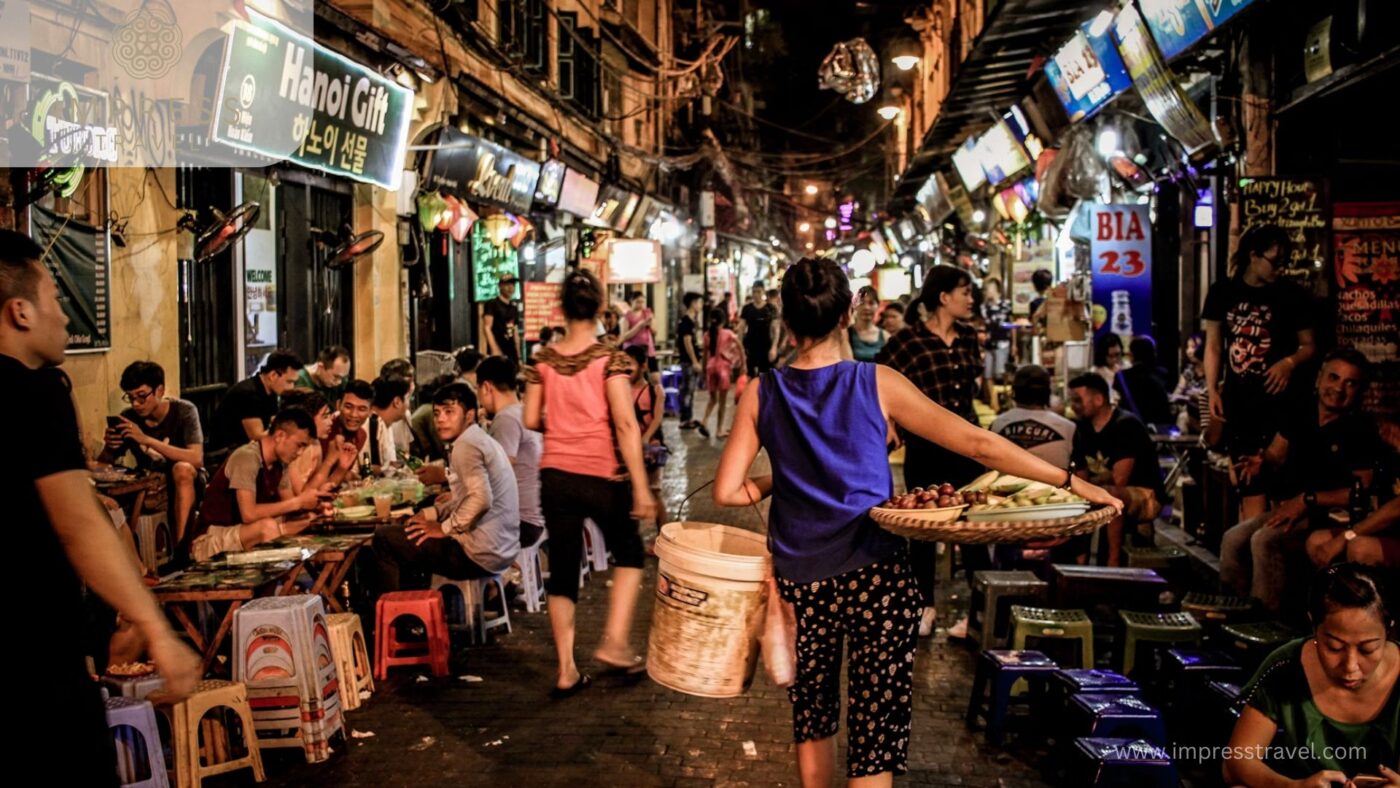
Bars and Social Spots
The lively spirit of Ma May Street after sunset is perfectly encapsulated by its cosmopolitan bars and social spots, which paint the night with colorful narratives of enjoyment and community. These establishments cater to varying tastes, offering a comprehensive nightscape ranging from casual meet-ups to sophisticated soirees.
Among them, the iconic 1900 Le Theater Bar stands as a beacon for younger crowds, merging traditional Vietnamese aesthetics with modern beats. Located on Ta Hien Street, it transforms into a buzzy nightclub experience, keeping the libations flowing and the dancefloor vibrant until the wee hours.
- Popular Bars:
- 1900 Le Theater Bar
- Fat Cat Bar
- The Alchemist
- Key Features:
- Unique Cocktails
- Trendy Ambiance
- Extended Hours
For those seeking a more laid-back encounter, Fat Cat Bar offers an inviting atmosphere perfect for mingling over a wide selection of cocktails and beverages. Its friendly vibe makes it a staple for both making new friendships and enjoying established ones within an intimate setting.
Meanwhile, The Alchemist exudes elegance, offering a more upscale vibe with its plush interior and jazz-inflected soundtrack. Here, patrons savor meticulously crafted cocktails tailored from exotic ingredients, casting a chic glow over relaxed, late-night conversations.
These social epicenters along Ma May Street pulsate with energy, providing an array of nocturnal diversions where memories are made, laughter is shared, and the spirited heart of Hanoi beats into the night.

Frequently Asked Questions (FAQs)
- What is the historical significance of Ma May Street?
- Ma May Street is renowned for its rich history, showcasing a blend of Vietnamese culture and French colonial architecture, indicative of Hanoi’s historical journey through centuries.
- What are the must-try foods on Ma May Street?
- Visitors should try nem ran (fried spring rolls), bun cha, and pho cuon, which are local favorites capturing the authentic flavors of Vietnamese cuisine.
- Which attractions are worth visiting on Ma May Street?
- The Ancient House at 87 Ma May and Bach Ma Temple are key attractions offering insights into traditional Vietnamese architecture and spiritual life.
- What makes Ma May Street a cultural hotspot?
- Its blend of traditional crafts, vibrant night markets, and historical sites underpins its status as a pivotal cultural corridor in Hanoi.
- How does Ma May Street evolve after sunset?
- As night falls, the street transforms into a vibrant hub with bustling night markets, lively bars, and eateries, showcasing Hanoi’s rich, nocturnal culture.
Conclusion
Ma May Street in Hanoi stands as a living archive of architectural brilliance, cultural vibrancy, and culinary delights. From its historical roots embedded in colonial legacies to the lively present-day amalgamation of tradition and modernity, Ma May seamlessly navigates through time, narrating stories of resilience, innovation, and communal harmony. A walk down Ma May Street is to journey through the heart of Hanoi’s cultural essence, beholden to steadfast artisanal traditions while embracing the dynamic pulse of contemporary life. Whether you’re a history enthusiast, a culinary connoisseur, or simply a curious traveler soaking in the sights and scents of the street, Ma May Street is an adventure awaiting to be discovered, etched in the memory long after the journey has ended.


